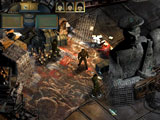 This seems to be the year for challenging some
long-held gaming formulas, what with System Shock 2's incredible mix of RPG and first
person shooter, and Outcast’s engaging blend of third-person action and adventure. So
what can be done to the old turn-based tactical strategy formula to spice it up? How about
throwing it into the mix with some slick role playing and genuinely frightening adventure.
What do you get? Odium. Is it any good? I’ll have some more. This seems to be the year for challenging some
long-held gaming formulas, what with System Shock 2's incredible mix of RPG and first
person shooter, and Outcast’s engaging blend of third-person action and adventure. So
what can be done to the old turn-based tactical strategy formula to spice it up? How about
throwing it into the mix with some slick role playing and genuinely frightening adventure.
What do you get? Odium. Is it any good? I’ll have some more.
Polish developers
Metropolis’ Odium is the result of the deft hybridization of turn-based strategic
combat and role playing, with enough adventure to make any adventure gamer happy, though
that type of player may also unfortunately be turned off by the great deal of strategic
fighting that serves as the centerpoint of the game. In fact, the combat is almost all of
what I remember of playing the game; walk a little, kill some stuff, walk a little
further, get killed by some stuff, over and over and over again. Whether you find this
tedious or exhilarating will depend whether or not you relish the idea of roasting
grotesque mutants with flame throwers, and doing it several times until you get it right,
which, if you’ve gotten this far reading this review, you probably will-so carry on.
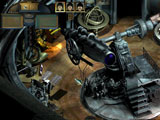 According to Monolith’s press release,
Odium features a “horrific conspiracy-based storyline that ties into reported
real-world occurrences.” I that's so, how come I haven’t seen any of those
giant - machine - gun - mounted - in - one - arm - big - sharp - metal - probe - on
- the - other - arm monsters on CNN? This whole X-Files paranoia has leaked into
everything; next thing you know someone’s going to claim that humans evolved on
another planet, traveled through space in DC-8's and disembarked into volcanos. Anyways,
you play as Lieutenant Cole Sullivan and his team of two other woefully unprepared
military “specialists” in exploring an ex-spy training facility in Poland. The
facility, which is actually a mock-city that was meant to be an exact replica of a typical
U.S. town, was supposedly abandoned soon after the end of the Cold War. Strange reports
came out of the area that called for another team of “specialists” to be sent
in, which was consequently--and not surprisingly--never heard from again. Enter you and
your team of twelve-bullet-packing commandos to search for the missing team and
investigate these reports of strange half-human, half-machine, and half-insect
monstrosities. According to Monolith’s press release,
Odium features a “horrific conspiracy-based storyline that ties into reported
real-world occurrences.” I that's so, how come I haven’t seen any of those
giant - machine - gun - mounted - in - one - arm - big - sharp - metal - probe - on
- the - other - arm monsters on CNN? This whole X-Files paranoia has leaked into
everything; next thing you know someone’s going to claim that humans evolved on
another planet, traveled through space in DC-8's and disembarked into volcanos. Anyways,
you play as Lieutenant Cole Sullivan and his team of two other woefully unprepared
military “specialists” in exploring an ex-spy training facility in Poland. The
facility, which is actually a mock-city that was meant to be an exact replica of a typical
U.S. town, was supposedly abandoned soon after the end of the Cold War. Strange reports
came out of the area that called for another team of “specialists” to be sent
in, which was consequently--and not surprisingly--never heard from again. Enter you and
your team of twelve-bullet-packing commandos to search for the missing team and
investigate these reports of strange half-human, half-machine, and half-insect
monstrosities.
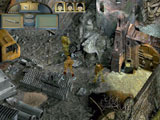 Soon after beginning the game, and I mean very
soon, you confront your first set of monsters; these can be taken out rather easily, but
they set the trend the rest of the game follows. You confront monsters-grotesque genetic
hybrids-and kill them. There are forty different monster types, most of which are pretty
cool, and though some look as if the developers were running out of good ideas and just
piled some stuff together, these may be the scariest monsters in the brood. A beast called
Grandma is one of the first boss monsters you encounter, and take my advice, don’t
pick on her three dog-things. Each of the monsters tend to have their own fighting style
and pace, which makes for the possibility of variation in your tactics, and little
diversity. Soon after beginning the game, and I mean very
soon, you confront your first set of monsters; these can be taken out rather easily, but
they set the trend the rest of the game follows. You confront monsters-grotesque genetic
hybrids-and kill them. There are forty different monster types, most of which are pretty
cool, and though some look as if the developers were running out of good ideas and just
piled some stuff together, these may be the scariest monsters in the brood. A beast called
Grandma is one of the first boss monsters you encounter, and take my advice, don’t
pick on her three dog-things. Each of the monsters tend to have their own fighting style
and pace, which makes for the possibility of variation in your tactics, and little
diversity.
There’s plenty
of combat, but the problem with having plenty of combat is that if a situation in the game
looks suspicious, then it is suspicious; if it looks like a trap, then it is a trap. After
you get over the initial surprise of having to fight every twenty paces the surprises lose
their surprising nature and it just becomes “oh joy, another fight.” The
challenge still remains, but predictability hangs around with it.
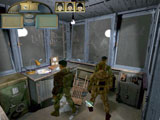 The actual implementation of fighting is my
biggest beef with the game. Combat can get really frustrating in Odium; not that it’s
especially hard, though it’s challenging enough, but with a little more thought it
could have been so much more dynamic. For instance, for some reason the developers decided
to use a square grid for character movement and weapon use. I feel a hexagonal grid would
make considerably more sense, lending a lot more choices in movement to the player and
therefore causing combat to be more complex and exiting. Another glaring oddity is the
fact that you can’t shoot pistols in diagonal directions. You can shoot you
rifles in diagonal directions, so why not pistols? The weapons restrictions in the game
are seemingly arbitrary and cause not a little consternation. Aside from the previous
problems combat tends to plod along. Read: it’s really slow. Fighting a couple of
lower-echelon monsters can take up to ten minutes, which is ten minutes I’d rather be
spending fighting real monsters or exploring. It would have been nice if the developers
would have thrown in some in-game options to speed up the combat animations, which occupy
most of the time you're fighting. The actual implementation of fighting is my
biggest beef with the game. Combat can get really frustrating in Odium; not that it’s
especially hard, though it’s challenging enough, but with a little more thought it
could have been so much more dynamic. For instance, for some reason the developers decided
to use a square grid for character movement and weapon use. I feel a hexagonal grid would
make considerably more sense, lending a lot more choices in movement to the player and
therefore causing combat to be more complex and exiting. Another glaring oddity is the
fact that you can’t shoot pistols in diagonal directions. You can shoot you
rifles in diagonal directions, so why not pistols? The weapons restrictions in the game
are seemingly arbitrary and cause not a little consternation. Aside from the previous
problems combat tends to plod along. Read: it’s really slow. Fighting a couple of
lower-echelon monsters can take up to ten minutes, which is ten minutes I’d rather be
spending fighting real monsters or exploring. It would have been nice if the developers
would have thrown in some in-game options to speed up the combat animations, which occupy
most of the time you're fighting.
There are a good
deal of NPC’s in the game, and from time to time you will be put in charge of them to
do with as you wish; just be careful and don’t trust them too much, it could end up
costing you. These character’s main purpose seems to be to forward the story within
the game, since you’ll spent most all of your time fighting. It’s a good idea to
listen to what they say. This will make decisions a little easier and help you avoid some
of the extraneous monsters. There are also a lot of cutscenes, some of them among the
coolest I’ve yet seen in games. Expect to be introduced to new monsters and have
coming battles foreshadowed in these scenes. I highly recommend--after finishing the game,
of course--exploring the Odium disk and checking them out again.
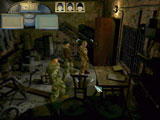 The RPG elements of the game are worked in
rather nicely; when a character has killed enough stuff and gained a level, an interface
pops up--even while in combat--and offers you the choice to where among your stats you
would like to add experience. I recommend working on your accuracy, as missed bullets can
deplete your rather paltry supplies of ammo with no reward. Also, while I’m thinking
about it, try to use your melee weapons as much as possible early on, and save the big
guns for the meaner looking monsters. Besides all that, save your game frequently. Items
will also need to be kept in inventory, and a good rule of thumb in the game is that if
you can pick it up, take it with you. Nine times out of ten you will find a use for it,
whatever it may be. The RPG elements of the game are worked in
rather nicely; when a character has killed enough stuff and gained a level, an interface
pops up--even while in combat--and offers you the choice to where among your stats you
would like to add experience. I recommend working on your accuracy, as missed bullets can
deplete your rather paltry supplies of ammo with no reward. Also, while I’m thinking
about it, try to use your melee weapons as much as possible early on, and save the big
guns for the meaner looking monsters. Besides all that, save your game frequently. Items
will also need to be kept in inventory, and a good rule of thumb in the game is that if
you can pick it up, take it with you. Nine times out of ten you will find a use for it,
whatever it may be.
Odium’s
graphics are really, really nice. The adventure screens are packed with loving detail, as
every nook and cranny is filled with rendered equipment, buildings, and debris. Most of
the game takes place in the standard camera angle that most all non-first or third-person
games take place in, or what they like to call the “bird’s-eye” view. For
this game it works well and no improvements could be made there.
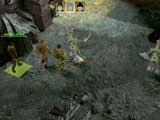 Amazingly, Odium is a single-player only game,
though it does sport a branching plot with plenty of twists and a couple of sub-quests,
replay value is rather low. It is a better than average sci-fi-horror game that will
appeal to fans of these genres, but may go unnoticed by most of the gaming community for
lack of marketing on Monolith’s part. This is quite unfortunate, as Odium, flaws
aside, is a unique game that deserves attention for its excellent graphics, sound, and
original gameplay. Amazingly, Odium is a single-player only game,
though it does sport a branching plot with plenty of twists and a couple of sub-quests,
replay value is rather low. It is a better than average sci-fi-horror game that will
appeal to fans of these genres, but may go unnoticed by most of the gaming community for
lack of marketing on Monolith’s part. This is quite unfortunate, as Odium, flaws
aside, is a unique game that deserves attention for its excellent graphics, sound, and
original gameplay.
--Thomas Hoff |
